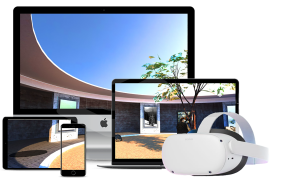What file formats are supported?
Where can I find the library of 3D items?
Uploading on LearnBrite Storage
Treating 3D items as Scenery (aka dropping items onto other items)
What file formats are supported?
We recommend using the files included in the LearnBrite library as they are already optimized, but if others need to be imported the preferred format is glTF (.glb/.gltf).
If that is not possible, the platform supports a variety of standard formats, including:
- FBX (.fbx), ASCII-encoded (binary encoded of FBX files are not supported at this time)
- Wavefront OBJ (.obj)
- Collada (.dae)
- 3D Manufacturing Format (.3mf)
Where can I find the library of 3D items?
The platform includes a library of 3D items, which can be accessed from the edit menu – by clicking on Add content. The content browser allows to search in the highly optimized LearnBrite library or to use 3rd party models from Sketchfab and Google Poly archive.
Note 3D items from Sketchfab and Google Poly archive are created by various authors and items will have varying levels of compatibility but may also lack optimization. Sketchfab does not include its entire library or paid items, it is limited to freely downloadable models under 100k polygons. It is possible using just one Sketchfab item in scene a warned about scene complexity could occur. Use the Status Monitor to check for complex items that might be impacting performance.
There are a number of guides available in the Academy to interface with different 3D model providers:
- Guide to using Remix3D and Paint3D with Scenario
- Guide to using Google Poly/Blocks with Scenario
- Guide to using SketchUp 3Dwarehouse with Scenario
- Guide to using SketchFab with Scenario
Uploading 3D Models
Uploading to Storage
Each Hyperspace Metaverse account includes hosting space.
You may upload 3D models, images, audio and mp4 files for use in your spaces.
To do so, you can follow this guide: https://hyperspace.mv/academy/storage-files/
Important: When uploading 3D models in GTLF, OBJ, FBX, DAE (Collada) format be sure to also upload the files & folders exported by your 3D tool, such as the .bin file for GTLF and all textures (.jpg / .png).
Bundling with ChatMapper
3D assets can be added to a ChatMapper project so they will be uploaded to the server with a scenario using ChatMapper Package export, which effectively creates a zip file.
There is a limit of upload size of 100MB for a ChatMapper Package |
- Add a New Item (CTRL+SHIFT+I) and name it
- In its properties, under “Pictures” click Add new file.
- In the newly added input box, click the […] button
- Choose a file that is in the same folder or subfolder of the .cmp project file
- Repeat for any file you want to bundle.
- When finished, click on File > Export > Chat Mapper Package (CMPKG); this will produce a zip file containing all the files referenced by the chatmapper project and create a conversation.json export in the zip at the same time.
- Upload the newly-exported CMPKG to dashboard as a scenario file. Be aware uploading a cmpkg will delete any historical files here such as conversation.json.
You might get an error when exporting the package. This will mostly happen in two cases:
|
If you need a URL for the file, a couple additional steps are required:
- In the scenario’s edit page (where you would upload the .json or .cmpkg files), a list of files will be presented after any successful upload.
- Get the path to your item by right clicking on the filename, and choose Inspect
- Copy the path and add https://app.learnbrite.com/dashboard/ to the front, which will give you a full URL, like https://app.learnbrite.com/dashboard/s/75dd9655eb7ec2c0f3779b7bd/Dell_Visor.glb
You can now add the item in edit mode using this URL.
Uploading on Dropbox
Dropbox only supports 3D items in a single file. We recommend using the .glb format, as it includes all geometry and textures in one file. glTF files that reference a .bin or texture files will not work, though you can use a service such as https://glb-packer.glitch.me/ to bundle glTF files into a single GLB.
To use a file from Dropbox:
- Get the share link for the file from dropbox
https://www.dropbox.com/s/ab86owawfyijyp0/Dell_Visor.glb?dl=0 - Re-write it as follows
https://dl.dropbox.com/s/ab86owawfyijyp0/Dell_Visor.glb - Add the item to the space using the modified URL
Uploading on Google Drive
Google Drive only supports 3D items in a single file. We recommend using the .glb format, as it includes all geometry and textures in one file. glTF files that reference a .bin or texture files will not work, though you can use a service such as https://glb-packer.glitch.me/ to bundle glTF files into a single GLB.
To use a file from Google Drive:
- Get the shared link for the file from Google Drive
https://drive.google.com/open?id=1aReG-2R5E6w8GSYo9w_lwnVBM1Z2Ffpz - Re-write it as follows:
https://hurl.learnbrite.com/pr/https://drive.google.com/uc?export=download&id=1aReG-2R5E6w8GSYo9w_lwnVBM1Z2Ffpz&.glb
- Add the item to the space using the modified URL
3D items as Static Scenery
3D items set to Static Scenery are automatically optimized for improved 3D performance as a consequence they do not support On Click interactions.
Setting 3D items as Static Scenery allows
- Easier editing and access to 3d items inside the bounding box of your 3D item
- Adding/editing hotspots on your 3D item
- Adding/editing interactive content on your 3D model, videos, pdfs, images, transparent trigger boxes/planes
- Locking 3D items in place so other space Editors (and yourself) don’t mistakenly mess up your work
Animated 3D Models
Include one or more animations in gltf or glb files.
The first animation will play automatically when the space loads.
Animations can also be controlled by playing and pausing or switching to alternative animations included in the 3d model file. Contact support to learn more about animation control actions.
Play the Lockout / Tagout scenario here.

